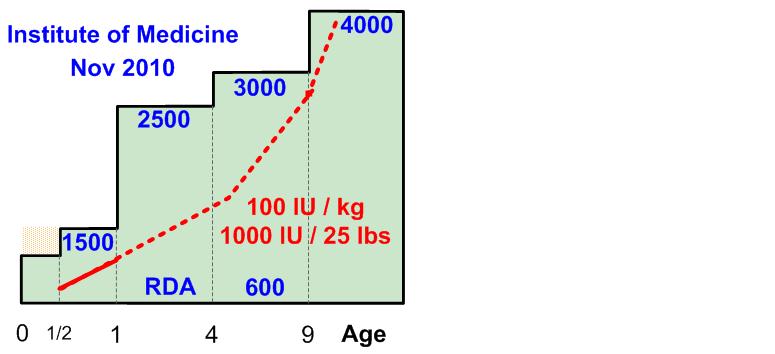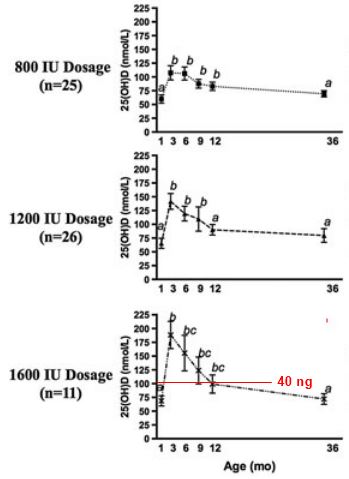Vitamin D improved child muscle mass even without varying dose with weight – RCT
Vitamin D supplementation trial in infancy: body composition effects at 3 years of age in a prospective follow-up study from Montréal
T. J. Hazell1, S. Gallo2, C. A. Vanstone3, S. Agellon3, C. Rodd4 andH. A. Weiler3,
Pediatric Obesity, Article first published online: 4 FEB 2016. DOI: 10.1111/ijpo.12105
Background: The impact of vitamin D status on body composition is not well understood.
Objectives: Evaluate how vitamin D supplementation in infancy affects body composition at 3 years of age.
Methods: Double-blind randomized trial of 132, 1-month-old healthy, breastfed infants randomly assigned to receive oral vitamin D3 supplements of 400, 800, 1200 or 1600 IU d−1 for 11 months. In the present analysis, 87 (66%) returned at 3 years of age. Body composition was measured using dual-energy x-ray absorptiometry and plasma 25-hydroxyvitamin D [25(OH)D] concentrations by liquid chromatography tandem mass spectrometry.
Results: Anthropometry, body composition, diet, activity and demographics were similar across dosage groups at 3 years. Mean 25(OH)D concentration from 1 month to 3 years was higher (P < 0.001) in the 1200 IU group than 800 and 400 IU groups. Children with 25(OH)D concentrations above 75 nmol L−1 had lower fat mass (~450 g; P = 0.049). In multiple linear regression, mean 25(OH)D was associated with lean mass percent (β = 0.06; CI: 0.00, 0.12; P = 0.042), fat mass (β = −11.29; CI: −22.06, −0.52; P = 0.048) and body fat percent (β = −0.06; CI: −0.12, −0.01; P = 0.045).
Conclusions
Higher vitamin D status from infancy through to 3 years of age associates with leaner body composition.
📄 Download the PDF from VitaminDWiki
 * Also would have had better results if had continued the vitamin D supplementation from age 1 to age 3
* Also would have had better results if had continued the vitamin D supplementation from age 1 to age 3
From the PDF: 1600 IU tallest, most active, leanest
Response to constant amount of vitamin D

1600 IU is too much at 1 month but too little at 12 months
Dose should not be constant, but be proportional to weight
See also VitaminDWiki
Infants getting up to 1600 IU did not increase blood level of vitamin D – RCT March 2016
- A later publication on this same study by many of the same authors
Intervention AND Infant/Child
{category}
Infant-Child category starts with
{include}
